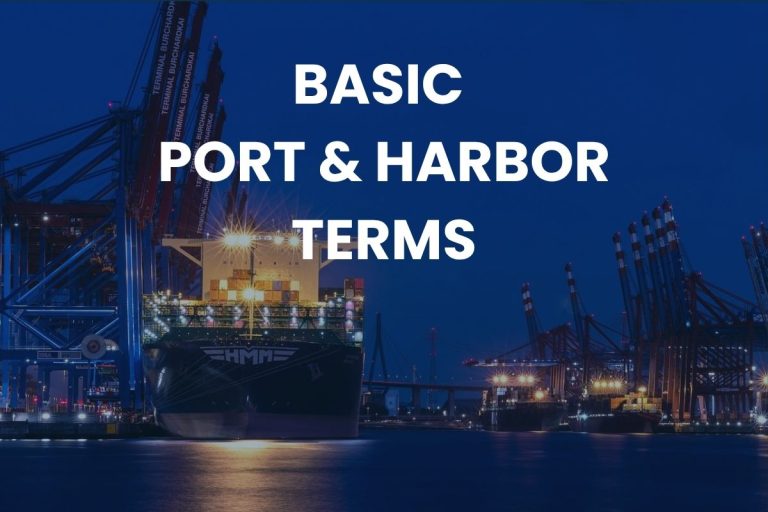Do you know that Asian countries have strong roots in agriculture? In their traditional agricultural systems, there are words that belong only to farming. Likewise, people in maritime operations use unique words for shipping, ports, and harbors. These words may sound strange at first. But once you understand them, you’ll see how much they matter in the shipping industry.
Ports and harbors are key to the global shipping network. Every ship, whether it’s carrying containers, oil, or passengers, must interact with these facilities. They are the link between sea and land, and without them, maritime trade would not be possible.
This article will introduce common port and harbor terms in maritime logistics, port management, and terminal operations. Whether you are a maritime student, a professional, or someone simply curious about how ports and ships work, learning these terms will help you understand the industry better.
1. Port
A port is a busy commercial area where ships arrive and depart for loading or unloading goods and passengers. Ports are built along coastlines or near rivers. It connects countries and seas in global trade. Most modern ports are man-made and have special facilities like container terminals, warehouses, cranes, customs offices, and repair areas. Governments or private companies can manage ports.
Well-known ports like Singapore, Rotterdam, and Shanghai handle millions of containers each year. A port can be a seaport, river port, dry port, fishing port, or passenger port. Each port serves a specific purpose.
2. Harbor
A harbor is a sheltered area of water where ships can anchor safely. It provides protection from wind, waves, and storms. A harbor can be a natural harbor as well as an artificial harbor. While a port provides full facilities for trade, a harbor mainly offers safe anchorage. As harbors provide natural protection, so many ports are built within them. Simply, a harbor offers safety. A port offers trade and services.
3. Dock
A dock is a man-made area in a port or harbor where ships tie up for loading, unloading, or repairs. Docks connect ships to the land and are essential for every port’s operation. Ports have different types of docks. They depend on the purpose.
Let’s look at the main types.
1. Dry Dock
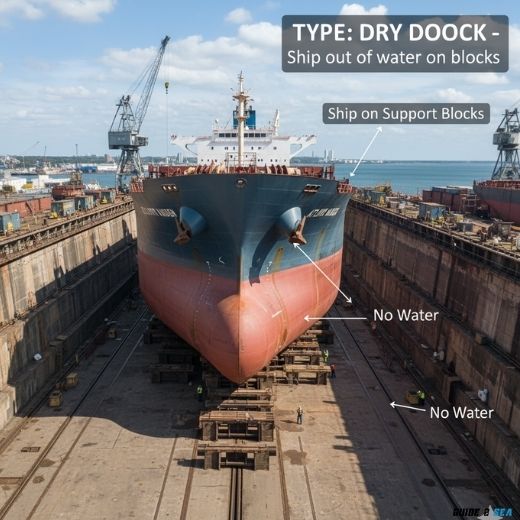
A dry dock is used when a ship needs repair or maintenance below the water line. It is a large basin that operators can fill and empty with water. The ship enters when the dock is full of water. After the ship enters, workers close the gates and pump out the water. So that the ship can rest on a platform. This technique allows workers to repair, clean, or paint the underwater parts. Dry docks are essential for ship inspections, especially when required by classification societies or port authorities.
2. Wet Dock
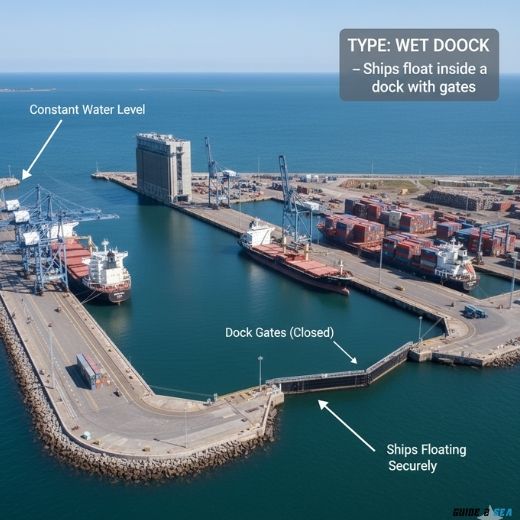
A wet dock keeps ships afloat in water for loading and unloading. The structure has gates to manage the water level. Wet docks are important in busy ports where ships arrive daily. The controlled water level makes it safer for cranes and workers to handle cargo efficiently. A dry dock empties water for ship repairs, whereas a wet dock holds water for normal port operations.
3. Floating Dock
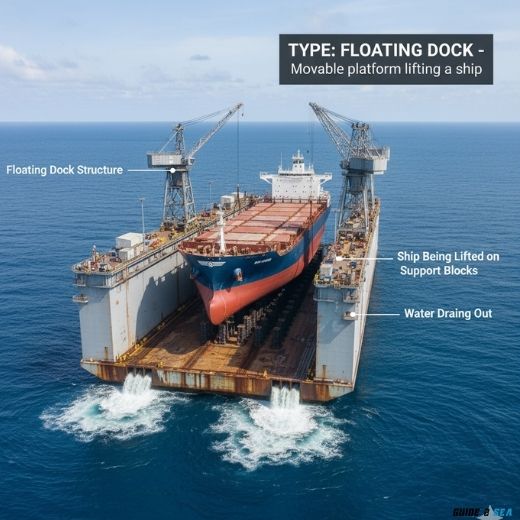
A floating dock is like a movable dry dock. It floats on the water. These docks serve areas that do not have a permanent dock. Floating docks can lift ships above the waterline using ballast tanks. These docks provide flexibility, cost savings, and the ability to move to new locations. These docks are useful for small shipyards, remote ports, or temporary repair works.
4. Lock
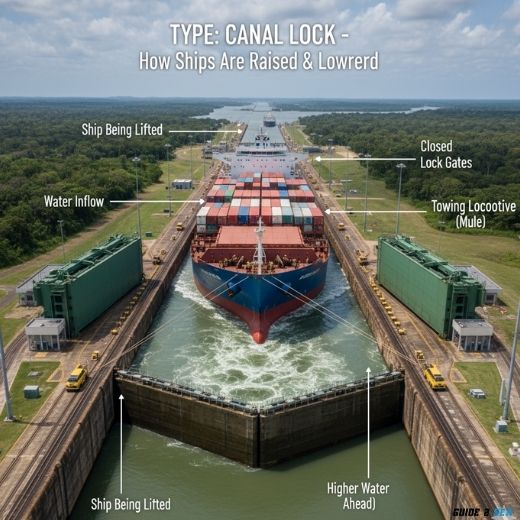
A lock is a unique structure in docks, canals, and waterways that controls water flow. It helps ships move between areas with different water levels. When a ship enters a lock, the gates close behind it. Then, locks adjust the water level to connect ships safely to the next section of a canal or dock Once the levels are equal, the front gate opens, and the ship continues its journey.
A famous example is the Panama Canal Locks. It allows ships to cross between the Atlantic and Pacific Oceans by raising and lowering them through a series of locks. These locks are like a water elevator for vessels. Locks make it possible for ships to travel through uneven waterways safely and efficiently.
5. Breakwater/Mole
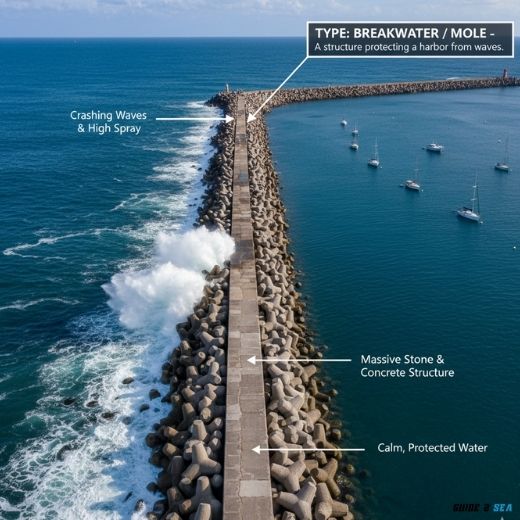
A breakwater, also called a mole. It is a solid wall built in the sea to protect a harbor or port from high waves and storms. It acts as a shield, reducing wave energy and keeping the water calm for ships inside the harbor. Ports build breakwaters from large rocks, concrete blocks, or steel to handle ocean forces, shaping them straight, curved, or angled to match wave directions. Without breakwaters, ports would face constant wave damage and unsafe docking conditions.
6. Wharf
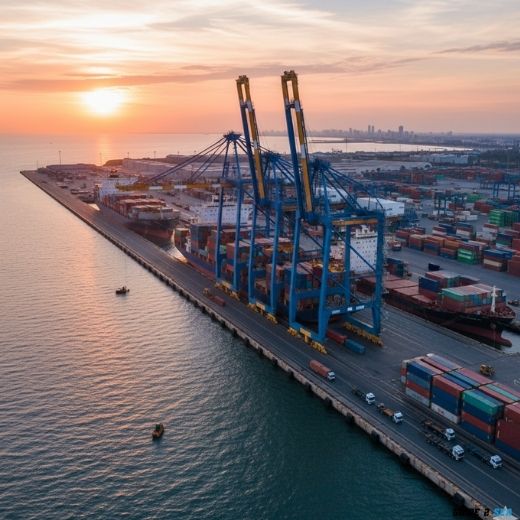
A wharf is a flat dock along the shore where ships load and unload cargo. It serves as a platform between ships and land, allowing people and cargo to move easily. Wharves are made from concrete, steel, or timber, depending on their purpose. They often have cranes, conveyors, or ramps to move heavy goods. Unlike a pier, a wharf runs parallel to the shoreline.
Almost every busy port has wharves. They handle heavy loads and frequent ship traffic. Container lifting, goods transferring, and other logistical activities happen at a wharf.
7. Pier and Jetty
People often use the words ‘pier’ and ‘jetty’ interchangeably, but each serves a slightly different purpose.
A pier is a long, raised structure that extends from the shore into the water. Ships can dock alongside it, and people or vehicles can move on it to load or unload goods or passengers.
On the other hand, a jetty is built to protect the coastline or guide ships into safe channels. It is often made from rocks or concrete blocks and helps control currents and tides at the entrance of harbors or rivers.
Both structures are essential in port design for ensuring safety and smooth movement of ships.
8. Dolphins
When you hear the word “dolphin,” you probably imagine dolphin fish at sea. But these dolphins you can only see at a port.
Dolphins are strong, man-made structures built in ports and harbors. They are often made from steel, concrete, or timber. Dolphins help with mooring ships, guiding vessels, and keeping ships aligned safely while docking.
You can often see dolphins in oil terminals or tanker berths, where ships need to be carefully positioned for safe loading and unloading.
9. Quay
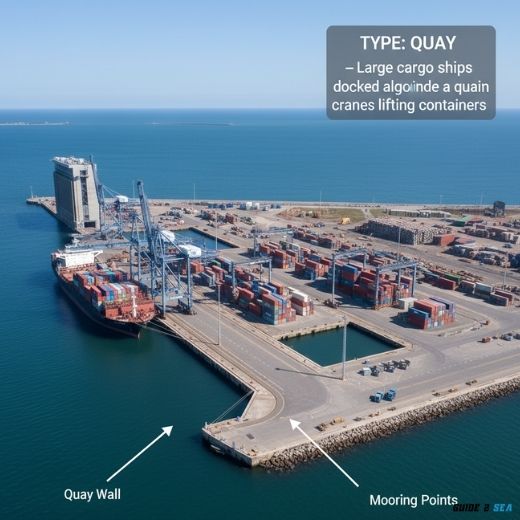
A quay (pronounced “key”) is a strong platform built along the shore where ships stop to load and unload cargo or passengers. People in British English commonly use the term “quay,” while in American English, it is called a “wharf.” They are usually made of strong concrete and built to support heavy cranes, trucks, and other equipment that help move cargo safely and efficiently.
Final Thought
Ports and harbors are like the heart of a country’s economy. Today more than 80% of global trade moves by sea. Every ship must pass through ports and harbors. When you start studying or working in the shipping industry, you will often hear terms like “dock,” “quay,” or “berth.” These aren’t just random words. They describe very specific things.
Knowing what each term means helps you communicate clearly, avoid confusion, and work safely and efficiently in the maritime field. It also gives you a strong foundation in maritime logistics and port management.
Read related articles

